Honest Money Gold & Silver Report - Market Wrap W/E 26th July
Stock-Markets / Financial Markets 2009 Jun 28, 2009 - 01:33 PM GMT The Economy - Some pretty good economic reports came out this week, at least on the face of it. The talking heads and spin masters were busy plying their trade. The art of deception lives on – unfortunately. Let’s dive beneath the surface(s).
The Economy - Some pretty good economic reports came out this week, at least on the face of it. The talking heads and spin masters were busy plying their trade. The art of deception lives on – unfortunately. Let’s dive beneath the surface(s).
First quarter GDP was revised up to an annualized 5.5 percent contraction. This is an improvement on the fourth quarters decline.
As the chart below shows, however, any way you slice it the result is the same – GDP was down 5.5% in the first quarter. Year-on-year growth is down -2.5 percent.
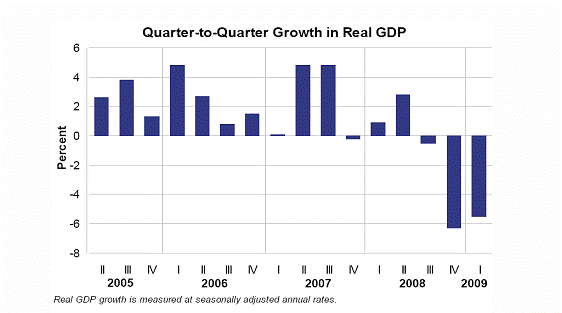
Personal income rose 1.4 percent in May. Now, this sounds good, however; wages and salaries, the largest component of personal income, fell 0.1 percent after increasing 0.1 percent in April.
The first chart below shows the “increase” in personal income and in personal spending, which was up 0.2 percent in May.

So, if the largest component of personal income fell (wages & salaries), what made total personal income rise 1.4%? According to the report it was the “other government spending” category. In total the government spent over $900 billion just in the month of May.
Now, where does the government get all that money from? Well, the government only gets money in one of two ways: they raise it via taxes; or they borrow it by selling Treasury bonds. The important point or difference between the two is that taxes do not generate an interest stream for the moneylenders – bonds do. That’s it – end of story; or the beginning – it all depends on one’s perspective.
Taxes are not providing the “new” money – it’s the monetization of T-bonds that is. It’s kind of absurd how our monetary system “works” or doesn’t “work”, once again, depending on one’s perspective.
Paper money or dollar bills, known as Federal Reserve Notes, are used by the Fed (and other entities) to purchase T-bonds with. In turn – or perhaps before, depending on one’s perspective, Treasury bonds “back” Federal Reserve Notes – a very interesting relationship to say the least. Symbiotic comes to mind.
Speaking of the Fed, the FOMC statement was released this week. It was quite interesting so we quote it in full:
Release Date: June 24, 2009
For immediate release
Information received since the Federal Open Market Committee met in April suggests that the pace of economic contraction is slowing. Conditions in financial markets have generally improved in recent months. Household spending has shown further signs of stabilizing but remains constrained by ongoing job losses, lower housing wealth, and tight credit. Businesses are cutting back on fixed investment and staffing but appear to be making progress in bringing inventory stocks into better alignment with sales. Although economic activity is likely to remain weak for a time, the Committee continues to anticipate that policy actions to stabilize financial markets and institutions, fiscal and monetary stimulus, and market forces will contribute to a gradual resumption of sustainable economic growth in a context of price stability.
The prices of energy and other commodities have risen of late. However, substantial resource slack is likely to dampen cost pressures, and the Committee expects that inflation will remain subdued for some time.
In these circumstances, the Federal Reserve will employ all available tools to promote economic recovery and to preserve price stability. The Committee will maintain the target range for the federal funds rate at 0 to 1/4 percent and continues to anticipate that economic conditions are likely to warrant exceptionally low levels of the federal funds rate for an extended period. As previously announced, to provide support to mortgage lending and housing markets and to improve overall conditions in private credit markets, the Federal Reserve will purchase a total of up to $1.25 trillion of agency mortgage-backed securities and up to $200 billion of agency debt by the end of the year. In addition, the Federal Reserve will buy up to $300 billion of Treasury securities by autumn. The Committee will continue to evaluate the timing and overall amounts of its purchases of securities in light of the evolving economic outlook and conditions in financial markets. The Federal Reserve is monitoring the size and composition of its balance sheet and will make adjustments to its credit and liquidity programs as warranted [emphasis added].
As we have seen, the Fed is correct in saying that the pace of economic contraction is slowing – they should add, however, that it still continues to contract significantly.
Although personal income was up – wages and salaries were down. It is government spending (fiscal stimulus) that is trying to raise all boats. But remember, the government does not have any money of its own; it can only get money from the people: by taxes or borrowing via the Treasury.
The money comes from the Fed, as the Fed creates it out of thin air, by magic. How do they do this? – By extending credit. Credit when accepted by the borrower creates both money and debt: the money that is owed with interest (debt) that was just created by the extension of credit. Sound nonsensical? That’s because it is.
In a system of paper fiat debt-money – credit, debt, and money are one and the same. That’s why we have a financial crisis on our hands. Our money is losing purchasing power (wealth) due to the over issuance of credit that creates debt, thus debasing the value (purchasing power) of our money.
Notice the highlighted portion of the FOMC statement. It talks about the Fed buying various debt instruments. Where does the Fed get the money to buy these debt instruments with? That’s right – they simply create it out of nothing. All it takes is a couple of clicks of a computer. Instant money – created faster than a Big Mac.
But doesn’t someone actually have to “pay” for all this? Yes, someone does. That would be all of us – We the People. All this over issuance of money, credit, and debt simply makes the purchasing power of our money go down. This loss of purchasing power is the most insidious tax ever known to man. Some call it inflation, some usury, others debasement of the currency; while some say it is the literal destruction of the currency – the death of paper money. Weimar Germany comes to mind.
I like to think of it as legal plunder. Think about it, long and hard – then vote accordingly. And remember: nationalism is socialism, which is corporate fascism – none of which are the same as a constitutional republic. The United States comes to mind.
In testimony on June 3 Bernanke told Congress that the Fed “will not monetize.” Perhaps we should watch what they are doing, rather than what they say. For example:
Reserve Bank credit declined for the week ending June 24, down $58.4 billion. The fall was led by a $53.8 billion decrease in term auction credit and a $28.7 billion decline in central bank liquidity swaps.
For the week, securities held outright advanced $30.8 billion. Treasuries gained $14.7 billion; mortgage-backed securities $11.8 billion; agency debt securities $4.3 billion; and primary credit $2.9 billion.
Some suggest that this may be a sign that the Fed is close to its limit on expanding its balance sheet. I’m not so sure of that. The nature of the beast is to inflate or die. I don’t think the beast wants to die. Though they stab it with their steely knives, they still can’t kill the beast.
Total assets on the central bank’s balance sheet have expanded by $1.17 trillion over the past year to $2.07 trillion, as the Fed loaned to banks, commercial paper issuers, financial institutions, all the while purchasing bonds to support the flow of credit; including toxic waste (debt) that no one else would dare touch (buy).
If the Fed stops monetizing debt, the system will implode. It already came quite close. This does not mean I agree with monetizing debt, as I don’t. Under the circumstances the only solution out of this mess is to return to the use of the only money mandated by the Constitution: gold and silver coin (and no bills of credit, i.e. paper money). The system cannot be fixed, it needs to be replaced – with the one the Constitution ordains. Anything less is accepting the unacceptable.
Is there any “proof” that the Fed’s machinations are all smoke and mirrors? Let’s look beneath the hood and see. Another stellar number was reported this week: personal savings.
Personal saving as a percent of disposable income rose to 6.9 percent in May. That is a good thing, as savings helps create true wealth. The chart below shows the recent rise in savings. Also, note the higher levels from which it has fallen over the past few decades.
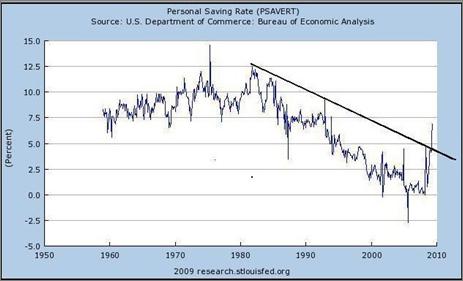
If wealth is destroyed faster than savings rise, there is still a negative net result. This is where the loss of purchasing power (wealth) by the debasement of the currency comes into play.
Inflated asset prices do not represent real wealth. They are an illusion, which can quickly be shattered, along with the credit extended based on the false valuations thereof. A promise for a promise is still a promise.
In 2009 savings increased about $2.7 trillion dollars. Not inconsequentially, as reported in the June 12th market wrap, as was the 23% surge is government spending, household wealth fell $1.3 trillion in the first quarter of 2009 to $50 trillion.
In 2007 household wealth was well over $60 trillion. Since then, savings has increased about $6 trillion, while household wealth decreased by almost $14 trillion. This is loss of wealth – plain and simple. The standard of living is decreasing – not increasing.
Watch what is happening, not what is said about what is happening. The two are not always the same. Also, the money supply (M1) has made a new high, so the Fed is obviously hard at it. The chart below tells the story:
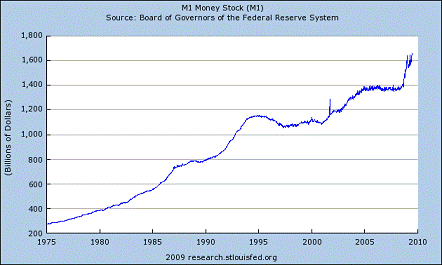
Moving along with the final economic report out this week, durable goods orders increased 1.8 percent in May.
Once again, this sounds good, however, year-on-year, new durable goods orders have increased ever so slightly; and from extreme negative levels: down 23.3 percent in May from minus 24.5 percent the month before.
But an increase is better than a decrease – just realize the size of the hill to be climbed.

Gold
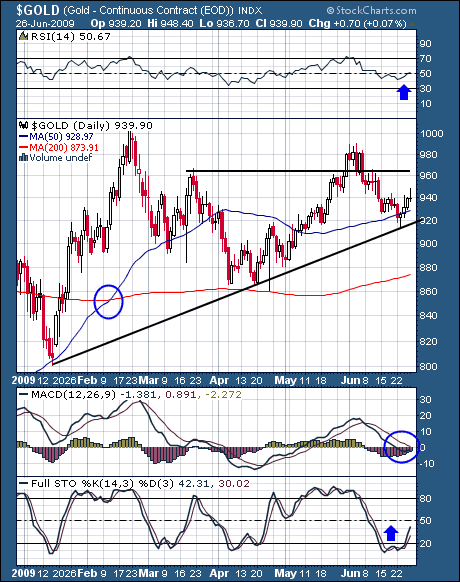 Gold had a pretty good week, gaining $5.40 to close at $939.90 (continuous contract). The daily chart below looks promising. Lower trend line support (diagonal black line) held on the recent correction.
Gold had a pretty good week, gaining $5.40 to close at $939.90 (continuous contract). The daily chart below looks promising. Lower trend line support (diagonal black line) held on the recent correction.
RSI and STO have turned up, with STO making a positive crossover up and through the 20 level. It also made a higher low in the process (double bottom). This is in keeping with the last two corrections on the gold chart.
The golden cross (50/200 dma) still dominates the chart; and note that both the 50 and the 200 ma’s are rising – we do not see this in any of the other markets that have made or look like they are about to make a 50/200 cross. All other markets have a falling 200 day moving average. Gold’s 200 ma is rising. This is a significant difference and is one of the reasons why gold is in a bull market. Up next is the weekly gold chart going back to 2005. The developing head and shoulders formation remains intact. Notice that the left shoulder is forming around the 850 level and that the 50 ma is just above at 874.
Both MACD and STO have turned down and made negative crossovers, which suggest lower prices are likely. This could be the head fake I have been concerned about. Prices could fall yet again and as long as the 850 level holds, the head & shoulders would still obtain, while shaking out a lot of players. The dollar factors in heavily.
Silver
Silver was down just under 1% for the week, closing at $14.08 (continuous contract). The daily chart shows silver is still under the dominant chart feature of the 50/200 dma golden cross it made back in March. Notice that as with gold, silver’s 200 dma is rising, although ever so slightly.
Silver has corrected down from the June high near $16 and is testing both horizontal support (black line) and its 50 dma at $14.02. This is an important test of support. MACD appears to be flattening out, while histograms are slowly receding back towards zero.
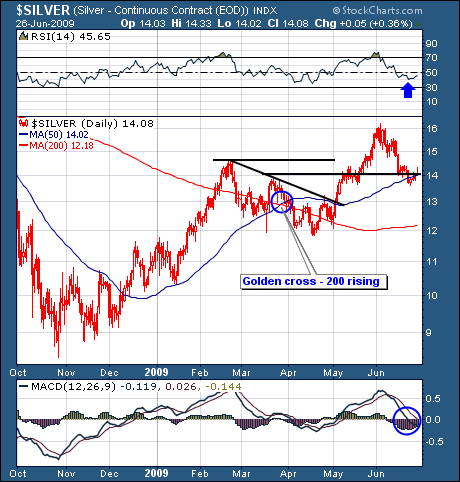

Gold Stocks
PM stocks, as represented by the GDX index, moved up 2% for the week, closing at 39.20. The daily chart shows horizontal support near 39 is being tested. This level is important, as it was just recently broken above, which means resistance has turned to support. Now support needs to hold. STO has put in a positive crossover and is headed up. However, MACD has yet to do the same, although the histograms are quickly receding towards zero. I will feel more bullish if and when an MACD cross occurs.
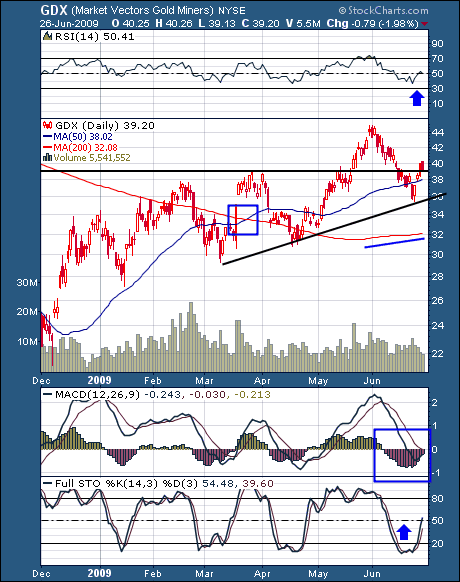
GDX made a golden cross (50/200 dma) back in mid-March. This is a longer term bullish sign. Notice the 200 dma is leveling out and looks like it may turn up, which would be very bullish and would give the cross more credence/power. Below, the chart shows the gold miners bullish percent reaching overbought levels and now breaking down below support. This warrants watching.
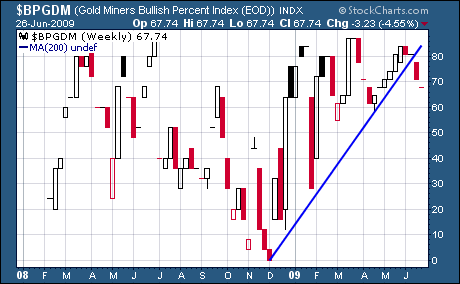
Invitation
The latest full-length version of this week’s market wrap is available only on the Honest Money Gold & Silver Report website. All major markets are covered with the emphasis on the precious metals. Stop by and check out our comments on gold’s potential profits and a list of the gold stocks that have outperformed the GDX by wide margins. The charts of gold denominated in three different currencies tell an interesting story.
We are so bullish on gold we are offering a money back guarantee if gold does not make a new high during 2009. A free trial subscription is also available. A copy of the new book: Honest Moneyis FREE with every new subscription.
Good luck. Good trading. Good health, and that’s a wrap.

Come visit our website: Honest Money Gold & Silver Report
New Book Now Available - Honest Money
Douglas V. Gnazzo
Honest Money Gold & Silver Report
About the author: Douglas V. Gnazzo writes for numerous websites and his work appears both here and abroad. Mr. Gnazzo is a listed scholar for the Foundation for the Advancement of Monetary Education (FAME).
Disclaimer: The contents of this article represent the opinions of Douglas V. Gnazzo. Nothing contained herein is intended as investment advice or recommendations for specific investment decisions, and you should not rely on it as such. Douglas V. Gnazzo is not a registered investment advisor. Information and analysis above are derived from sources and using methods believed to be reliable, but Douglas. V. Gnazzo cannot accept responsibility for any trading losses you may incur as a result of your reliance on this analysis and will not be held liable for the consequence of reliance upon any opinion or statement contained herein or any omission. Individuals should consult with their broker and personal financial advisors before engaging in any trading activities. Do your own due diligence regarding personal investment decisions. This article may contain information that is confidential and/or protected by law. The purpose of this article is intended to be used as an educational discussion of the issues involved. Douglas V. Gnazzo is not a lawyer or a legal scholar. Information and analysis derived from the quoted sources are believed to be reliable and are offered in good faith. Only a highly trained and certified and registered legal professional should be regarded as an authority on the issues involved; and all those seeking such an authoritative opinion should do their own due diligence and seek out the advice of a legal professional. Lastly Douglas V. Gnazzo believes that The United States of America is the greatest country on Earth, but that it can yet become greater. This article is written to help facilitate that greater becoming. God Bless America.

Douglas V. Gnazzo © 2009 All Rights Reserved
© 2005-2022 http://www.MarketOracle.co.uk - The Market Oracle is a FREE Daily Financial Markets Analysis & Forecasting online publication.



